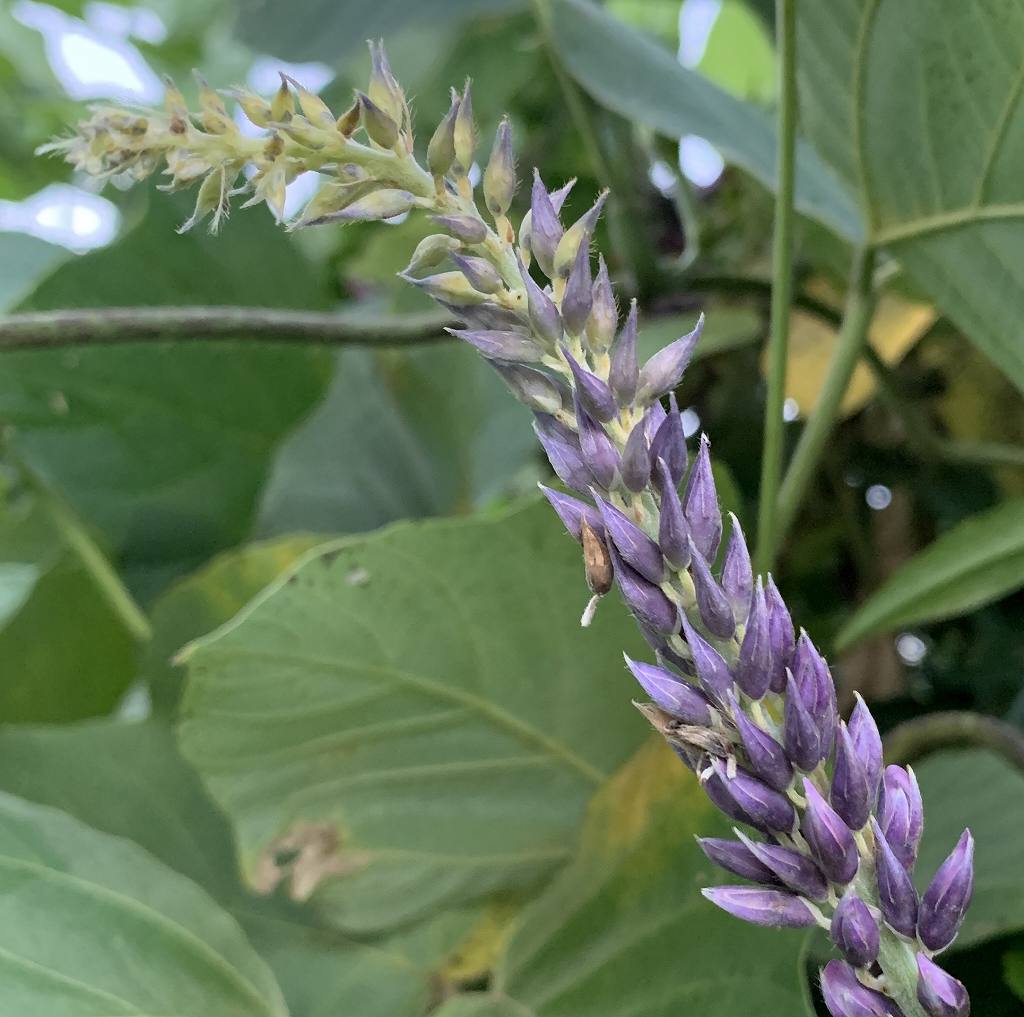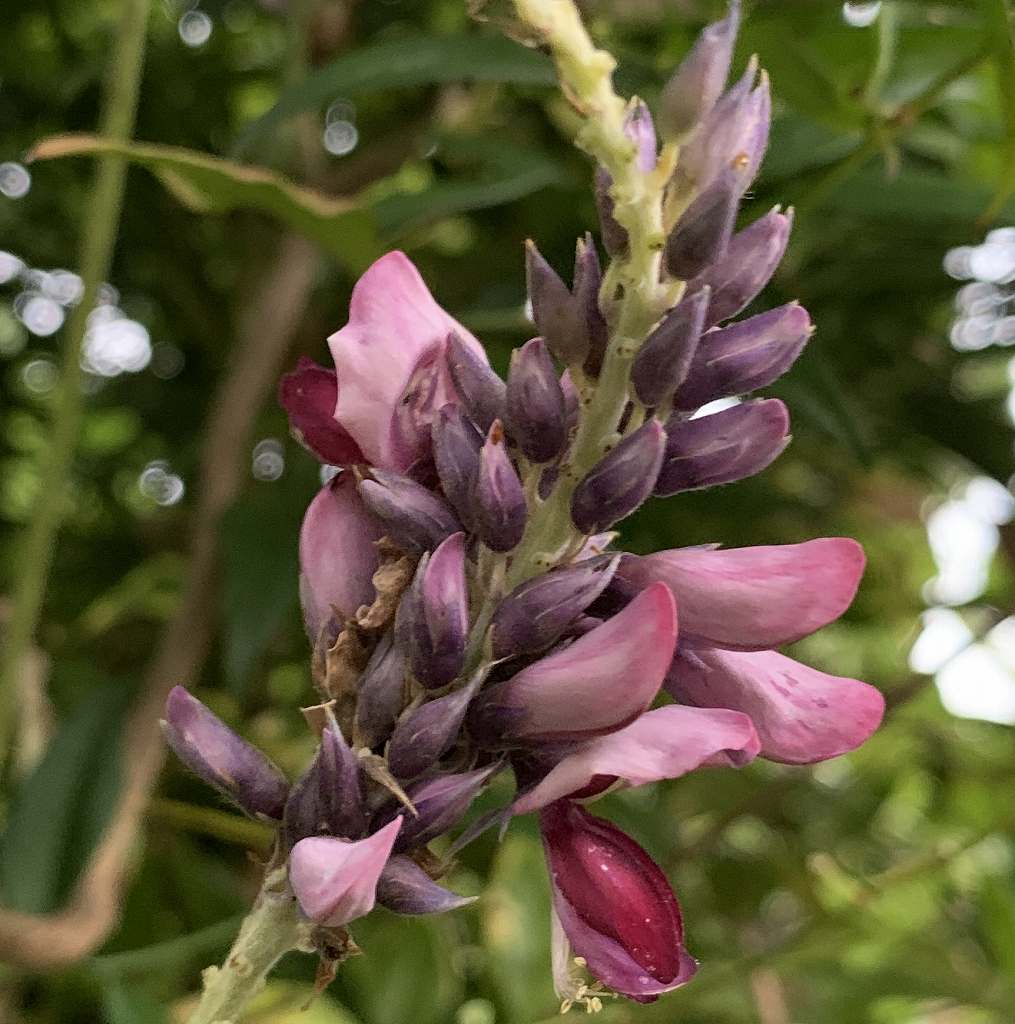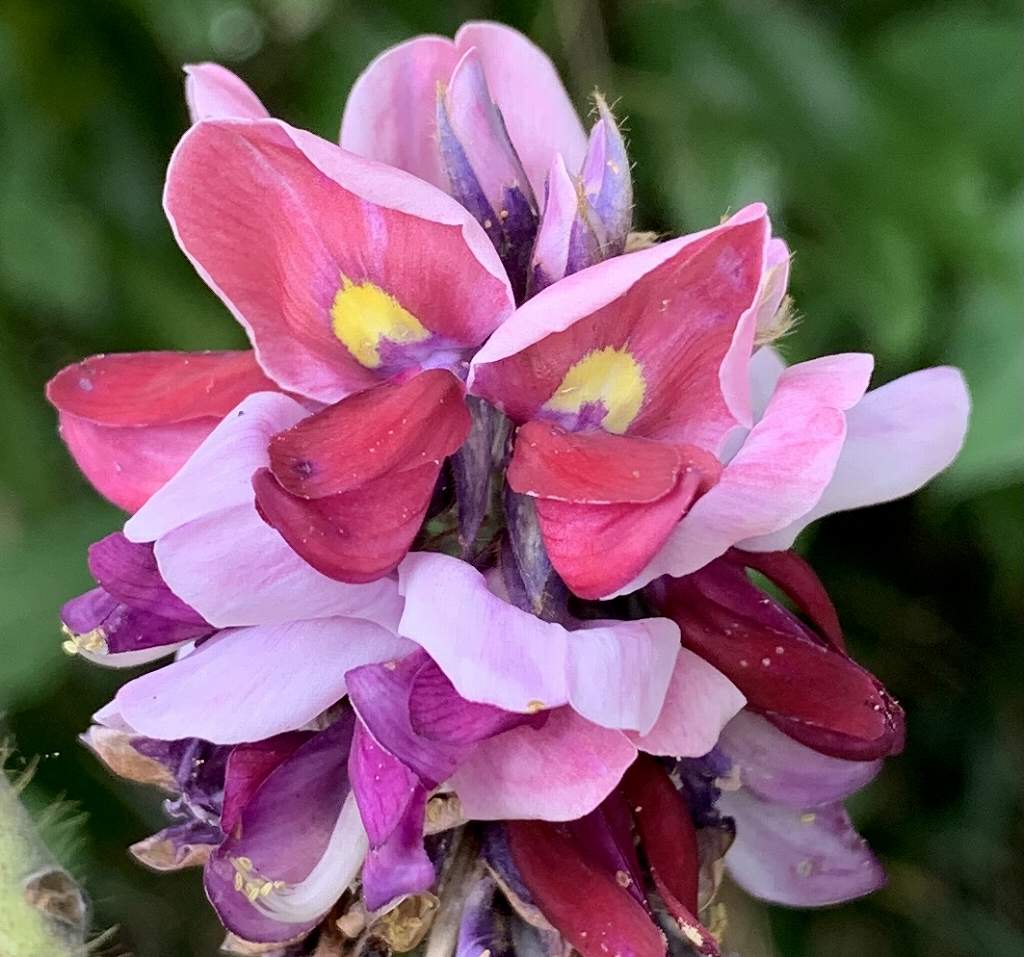クズの花は、緑の香りとブドウの香りが合わさった甘く爽やかな匂いです。花穂の色は濃紺紫。房状に密集した蝶形花が下から順に咲きます。
Kudzu flowers have a sweet and refreshing scent that combines the scent of green and the scent of grapes. The color of the flower spikes is dark blue purple. Dense tufted butterfly-shaped flowers bloom in order from the bottom.
【仮名】クズ
【和名】葛
【英名】Kudzu
【学名】Pueraria montana
【誕生】09/ 12, 09/ 21
【開花】08, 09月
【花色】White, Pink, Red, Purple, Violet, Blue



クズ
クズの生態
クズはマメ科の蔓性多年草です。分布は温暖な地域で、日本から中国、フィリピン、インドネシア、ニューギニアまで。国内では北海道から九州まで、各地に自生しています。山野の林内や林縁、荒れ地、土手などで多く見られ、人手の入った薮で繁茂。根茎と種子により増殖します。
クズの茎葉
クズの茎葉は地面を這い回ります。蔓は他のものに巻きつきながら長く伸び、全体に褐色の細かい毛が発生。根元は木質化し、地下では塊根が大きく肥ります。葉は幅が広く草質で、葉柄が長く、互生し、受ける日光の強さで角度が変化。葉の裏面は毛が密生し、白色を帯びています。
クズの花
クズは花穂が立ち上がり、蝶形花が房状に密集。花を下から順に咲かせます。花色は濃紺紫ですが、「白花葛」「朱鷺色葛」のような変異も。花には芳香があります。緑の香りとブドウの香りが合わさった甘く爽やかな匂い。花後は褐色の剛毛に被われた大きく扁平な果実を結びます。
クズの雑草化
クズは繁殖力が旺盛。地上の蔓を刈り取っても、地下に根茎が残るので、すぐに蔓が再生します。昔は蔓が作業用の資材になったので、定期的に刈り取られましたが、今は放置。除草剤にも強く、いったん雑草化すると根絶が困難です。海外では世界の侵略的外来種に指定されるほど。
クズの食用
クズは塊根に含まれるデンプンを「葛粉」で利用。葛粉を湯で溶かしたものが「葛湯」です。葛湯が冷えて固まると透明になり、「葛切り」「葛餅」などの和菓子に。料理のとろみ付けにも使われます。また、春先から初夏にかけて伸びる蔓の先端は柔らかく、お浸しや天ぷらなどに。
クズの薬用
クズの根と花と葉は、古くから日本や中国で用いられる生薬。「葛根」は発汗作用・解熱作用・鎮痛作用があり、風邪の初期症状に用いられる葛根湯の主薬です。「葛花」は有効成分がイソフラボンで内臓脂肪や皮下脂肪を減らし、二日酔いにも。「葛葉」は傷の止血に用いられます。
クズの花言葉
クズは食用され、根と花と葉が生薬にもなることから、花言葉は「活力」「治癒」。一方、旺盛に伸長し、駆除が難しいことから「根気」「芯の強さ」「努力」という花言葉もあります。また、花言葉ではありませんが、秋の七草の1つ。秋の季語として多くの俳句に詠われています。
Kudzu
Ecology of Kudzu
Kudzu is a perennial vine of the leguminous family. The distribution is warm, from Japan to China, the Philippines, Indonesia and New Guinea. In Japan, it grows naturally in various places from Hokkaido to Kyushu. It is often found in mountain forests, forest edges, wastelands, banks, etc., and is flourishing with man-made bushes. Proliferates with rhizomes and seeds.
Kudzu foliage
The foliage of Kudzu crawls on the ground. The vine grows long while wrapping around other things, and fine brown hair is generated throughout. The roots become woody, and the bulbs grow heavily underground. The leaves are wide and grassy, with long petioles, alternate, and the angle changes depending on the intensity of sunlight received. The underside of the leaves is densely haired and tinged with white.
Kudzu flower
The spikes of the Kudzu stand up, and the butterfly-shaped flowers are densely packed in tufts. The flowers bloom in order from the bottom. The flower color is dark blue purple, but there are also variations such as “white flower kudzu” and “red ibis color kudzu”. The flowers have a fragrance. A sweet and refreshing scent that combines the scent of green and the scent of grapes. After flowering, it ties large, flat fruits covered with brown bristles.
Weeding of Kudzu
The scraps are very fertile. Even if the vines on the ground are cut, the rhizomes remain underground, so the vines will regenerate immediately. In the old days, vines became a material for work, so they were cut regularly, but now they are left alone. It is also resistant to herbicides and is difficult to eradicate once it becomes a weed. Overseas, it is designated as an invasive alien species in the world.
Edible Kudzu
Kuzu uses the starch contained in the bulbs as “kudzu-ko”. “Kudzu-yu” is made by dissolving kudzu powder in hot water. When the kuzu-yu cools and hardens, it becomes transparent and becomes a Japanese sweet such as “Kuzukiri” and “Kuzumochi”. It is also used to thicken dishes. In addition, the tip of the vine that grows from early spring to early summer is soft, making it suitable for soaking and tempura.
Medicinal Kudzu
Kudzu roots, flowers and leaves are crude drugs that have been used in Japan and China for a long time. “Kakkon” has sweating, antipyretic and analgesic effects, and is the main drug of Kakkonto used for the initial symptoms of colds. “Katsuka” is an active ingredient that reduces visceral fat and subcutaneous fat with isoflavone, and is also suitable for hangovers. “Katsuyou” is used to stop bleeding from wounds.
Flower language of Kudzu
Since the Kudzu is edible and the roots, flowers and leaves are also herbal medicines, the flower language is “vitality” and “healing”. On the other hand, since it grows vigorously and is difficult to exterminate, there are also flower words such as “perseverance,” “core strength,” and “effort.” Also, although it is not a flower language, it is one of the seven autumn herbs. It is written in many haiku as an autumn season word.


